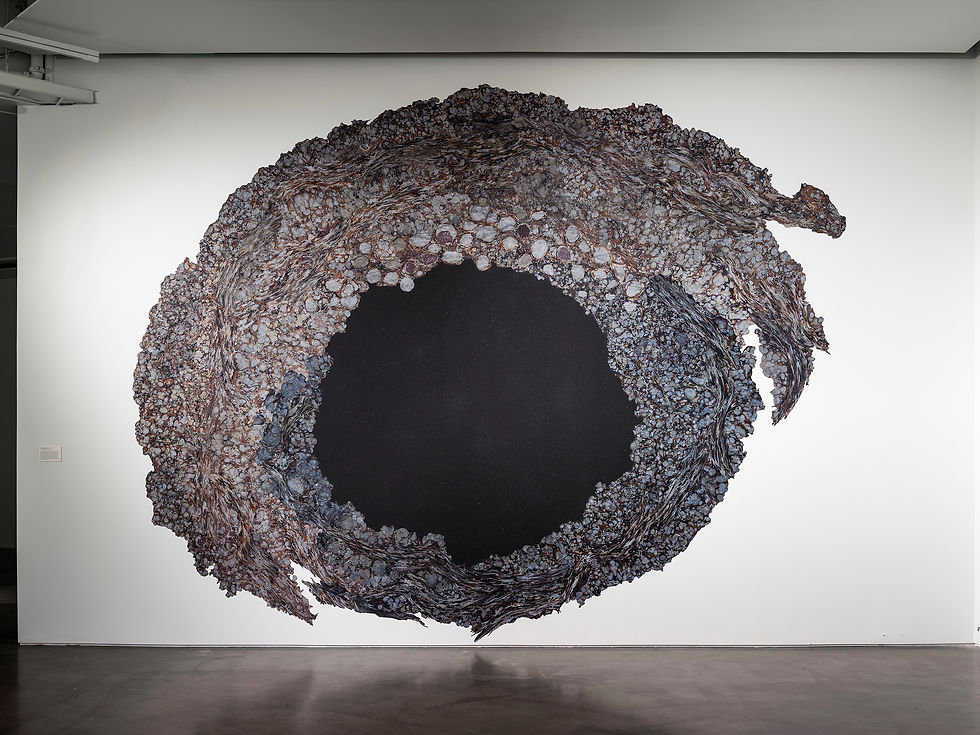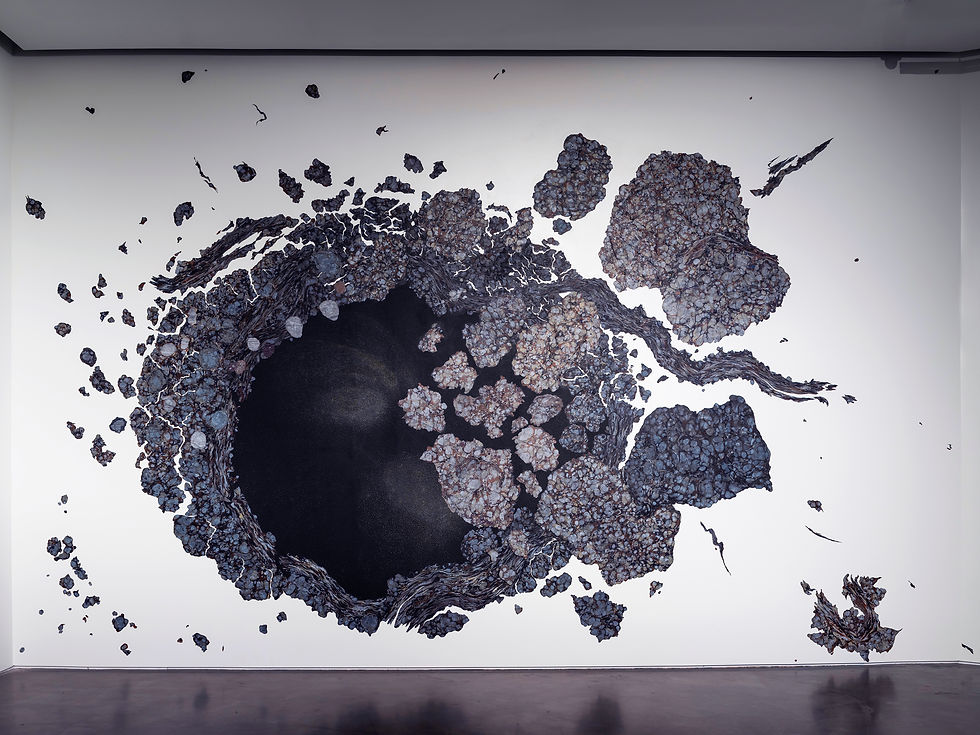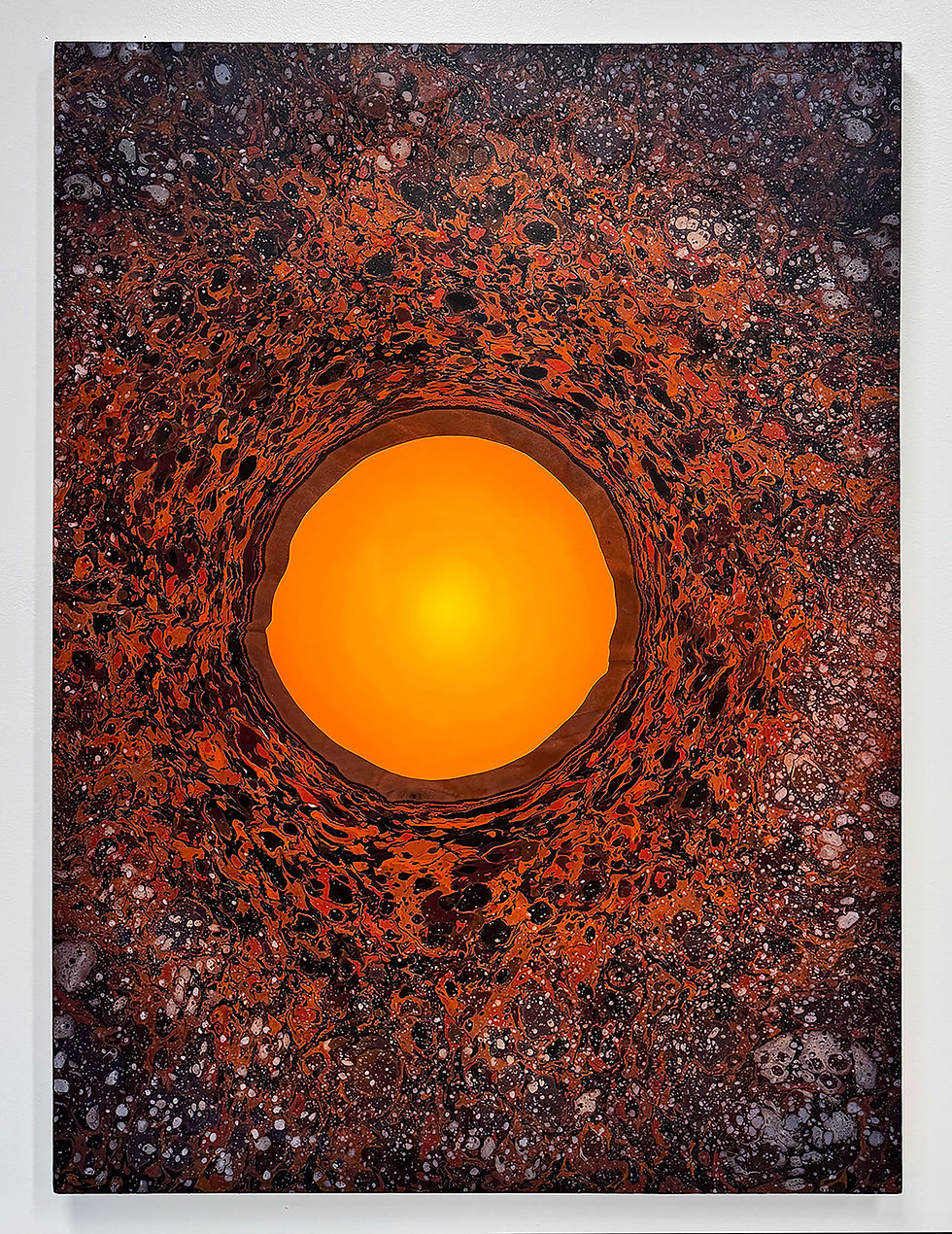Artist Molly Kaderka
- Ada Nwonukwue

- Sep 24, 2025
- 5 min read
Updated: Oct 28, 2025

Molly Kaderka is a painter working in the expanded field of painting, which spans the disciplines of printmaking, drawing and painting. Her work is inspired by her deep interest in natural phenomena and in human and earth history.
Kaderka holds a BFA in Painting and Art History from the Kansas City Art Institute and an MFA in Painting from the Rhode Island School of Design. Her work has been shown nationally, including in solo exhibitions at the Haw Contemporary in Kansas City and Jamestown Art Center in Rhode Island, and in group shows at Morgan Lehman Gallery (NYC), Asya Geisberg Gallery (NYC), Attleborough Museum of Art (MA), Newport Art Museum (RI), Utah Museum of Contemporary Art, and most recently, in The Soul Is A Wanderer, at Oklahoma Contemporary. Her work has been featured most recently in articles in Hyperallergic (January 2024) and in the Paris-based Le Quotidien de L’Arte (December, 2023).
Recent awards include the Grand Award at the Delta Triennial at the Arkansas Museum of Art, Hargis Fellowship at the Doel Reed Center in Taos (NM), the Walter Feldman Fellowship, issued by Arts and Business Council of Boston; the Visual Arts Artist Fellowship Grant issued by the Somerville (MA) Arts Council, and an Inspiration Grant from the Kansas City Artist Alliance. She has also received two HAD research grants from Oklahoma State University.
Kaderka has taught painting and drawing at Kansas City Art Institute, Maryland Institute College of Art, Rhode Island School of Design, and Massachusetts College of Art and Design, Oklahoma State University, and is currently an Assistant Professor at Wake Forest University, where she teaches painting.

"My artistic practice is based in painting but also spans the disciplines of printmaking, drawing, and most recently, paper marbling. My recent work, a series using Ebru Marbling, seeks to reimagine the traditional Western format of landscape painting by removing linear and atmospheric perspective (the meeting of earth and sky at a distant horizon) while still maintaining recognizable elements of earth and sky. Using large-scale, site-specific works that combine the ancient craft of paper marbling with elements of painting and drawing, the series depicts the celestial and terrestrial realms in a unique spatial relationship to each other. Unlike traditional landscape, which assumes a viewer looking straight ahead to an illusory horizon line, where earth meets sky, these pieces put earth and sky in the same plane, within a circular structure that has no beginning or end. Framed by a tactile rock surface, the circular compositions act as an aperture to the distant, intangible stars. The works are typically developed for a specific exhibition space and are laminated directly to the gallery walls and floors, giving them an immediacy and presence that heightens the sense of the nearness of the vast universe."

Tell us a little about yourself (where you are from) and your background in the arts.
I’m originally from Austin, TX, and I was fortunate to have my creative impulses encouraged from an early age. I studied painting and art history at the Kansas City Art Institute before earning my MFA in painting from the Rhode Island School of Design. At RISD, I fell in love with drawing, printmaking, and other process-based approaches that continue to inform my practice today, and it was also where my interest in astronomy and geology began to shape the way I think about landscape and time.
During the COVID-19 pandemic, when access to print shops was limited, I began teaching myself marbling. First with suminagashi in improvised setups like my bathtub, then later with Ebru marbling, a traditional Turkish form. Ebru marbling was a game-changer for me, merging the spontaneity of painting with the indirect mark-making of printmaking. It has since become central to my work.
Alongside my studio practice, I’ve also had a teaching career that has taken me across the country. I’m currently an Assistant Professor of Painting at Wake Forest University.
What kind of work are you currently making?
Right now, I’m working on an installation of hanging marbled chiffon fabric. The semi-transparency of the material allows light to filter through and the surface seems to subtlety shift and change as the viewer moves around it. I’m also introducing suspended sculptural rocks between the layers of fabric, giving the marbling a new three-dimensionality. So, what usually lies flat on paper is now occupying space, and shifting between image and object, surface and form.
I have also, slowly, been experimenting with making my own marbling paints by collecting dirt samples from specific sites. Through this process I am hoping to tie the work directly to place, literally embedding geological history into the images themselves. For me, making my own paint is both a material investigation and a way of thinking about landscape as something embodied.
What is a day like in the studio for you?
A typical day in the studio really depends on where I am in the process, but it almost always involves long stretches of focused, detailed work. Sometimes that means repetitive actions, like tapping thousands of stars onto the surface of a painted night sky or meticulously cutting intricate patterns or textures from sheets of marbled paper. Other times it’s physically demanding, especially when I’m marbling on a large scale. Once the marbling bath is prepared, I’m on a time crunch—the water only stays stable for so long—so I have to work quickly and almost nonstop until the pulls are finished.
No matter the stage, my practice always involves labor-intensive detailed work. While exhausting at times, I find it both invigorating and meditative. Each stage of my process has its own unique rhythm which keeps me closely attuned to the materials and continually generating new questions for future pieces.
What are you looking at right now and/or reading?
Lately, I’ve been looking closely at Jack Whitten’s work. I saw his retrospective at MoMA this summer and was struck by his lifelong commitment to process and material. His slab paintings are remarkable. I’ve also been especially interested in his toner drawings and the way they expand his exploration of mark-making. This is a process I’m interested in exploring in my own studio.
In terms of reading, I just finished Ninth Street Women and loved how it reads like a story while also filling in historical context I only knew in fragments. The book brought that period of art history to life for me, and how the women at its center like Lee Krasner, Elaine de Kooning, and Helen Frankenthaler, were completely uncompromising in their pursuits to make paintings.
I’m also part of a book club that is reading Graham Harman’s Art + Objects. His argument for aesthetics as central to philosophy, and for the agency of objects through Object-Oriented Ontology, has been challenging but illuminating. While it doesn’t map directly onto my practice, the book does challenge the assumption that objects don't derive meaning only from human use, but instead exist within their own networks of relations independently from us.
Where can we find more of your work? (ex. website/insta/gallery/upcoming shows)
Website: www.mollykaderka.com
Instagram: https://www.instagram.com/mkaderka/








Comments